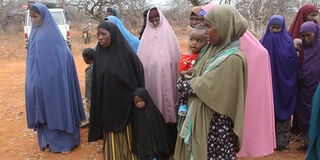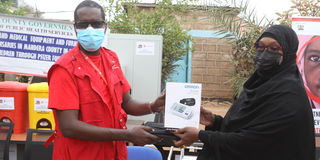Premium
Report cites factors hindering child immunisation in Mandera

Women and their children outside a newly renovated Hardimtu Dispensary in Mandera. Majority of children in the county are never fully immunised due lack of facilities and long distances to the few available health centres.
Since giving birth to her firstborn child in January 2020, Ms Halima Ibrahim, a resident of Hardimtu in Mandera West sub-county, can only recall having her child immunised thrice.
“I only saw a doctor when I went to Takaba Hospital, which is 70km away from our village. My baby was also given a dose when some health workers came here on a medical outreach,” she said.
Just like Ms Ibrahim, many other mothers in Mandera West, Banisa and Mandera North sub-counties residing in villages far away from main hospitals or in areas with no health facilities have not had their children fully immunised.
They cite long distances to the main hospital and lack of knowledge about immunisation as the key reasons for this.
Additionally, misconceptions about immunisation are a major challenge in Mandera County. Others include nomadic lifestyles, lack of access to health facilities and lack of storage facilities for vaccines.
“I think moving from one place to another in search of water and pasture made me not have my children fully immunised,” Ms Ibrahim said.
Baseline survey report
A baseline survey report released last December by Save the Children on factors affecting access, supply and demand for immunisation services among caregivers of children under five years of age revealed the loopholes.
In the report, most of Mandera County’s key health statistics mark below national averages. For instance, the proportion of fully immunised children in the county was 28 per cent against the national average 71 per cent.
Health inequalities continue to be a major challenge in Mandera County, attributed to various factors including prolonged marginalisation, inadequate health infrastructure, high illiteracy levels, insecurity, socioeconomic factors and the nomadic lifestyle.
Although some major investments in the health infrastructure have been made in the county, still over 60 per cent of locals practise a nomadic lifestyle and live over 20km away from the nearest health worker or health facility.
This is against the WHO recommendation of a maximum of a five-kilometre radius to the nearest health facility.
Due to the nomadic lifestyle, basic health services are provided by traditional healers, traditional birth attendants and religious leaders who are part of the mobile community.
With a workforce of 1,172 in healthcare, the county has a total of 93 operational health facilities and 14 non-operational ones.

Mr Abdalla Shariff, Save the Children Programme Coordinator in Mandera County, hands over equipment to the county chief officer for public health, Ms Rahama Abdullahi.
Immunisation project
The Save the Children Mandera area office is implementing a three-year immunisation project funded by the Pfizer Foundation in collaboration with the county’s Health department in a bid to reduce the needless deaths of children under the age of five.
To fulfil the requirements of research involving human subjects, the study received clearance from Strathmore University’s Ethical Review Committee, a reputable ethical clearance body accredited by the National Council for Science Technology and Innovation (Nacosti) in Kenya.
The baseline study was cross-sectional in nature and both primary and secondary data were used.
The study respondents included the primary caregivers of children aged 0-59 months and key informants including the government, partners and community health workers.
Among all the respondents, 61 per cent in Mandera reported that their children were fully immunised.
The reasons for children not being fully immunised were varied.
The respondents cited the main reasons as vaccine unavailability, unavailability of vaccinators in health facilities, long distances to the facilities, lack of time and lack of transport.
On immunisation plans by caretakers, 32 per cent in Mandera reported their children will receive all recommended vaccines.
Only two per cent reported that their children would receive some but not all the recommended vaccines.
Communication strategies
The participants suggested that in order to improve access to immunisation services, traditional health communication strategies such as the use of community health volunteers (CVHs), health workers, public barazas, religious gatherings, household sensitisation, use of elders and seminars were critical.
According to the survey, the hepatitis vaccine was the most reported out-of-stock vaccine followed by the yellow fever vaccine.
Only 47 per cent of the facilities had freezers and the average distance to a health facility in Mandera ranged between 25 and 50 kilometres.
To improve coverage, utilisation, access and quality of immunisation services in Mandera, Save the Children has refurbished 16 facilities.
The county received donations of cold chain, medical equipment and furniture worth Sh11 million from Save the Children International with support from the Pfizer Foundation.
“Save the Children is passionate about children’s health. We work with the government and partners to reduce maternal and newborn care by scaling up high impact interventions as we advocate for improved health systems,” said Mr Abdalla Shariff, Save the Children’s programme manager in Mandera County.
Health Chief Officer Rahama Abdullahi lauded the support from donor agencies.
“We appreciate the support we are getting from donor agencies because it will definitely boost our efforts in providing health services to our local community,” she said.





